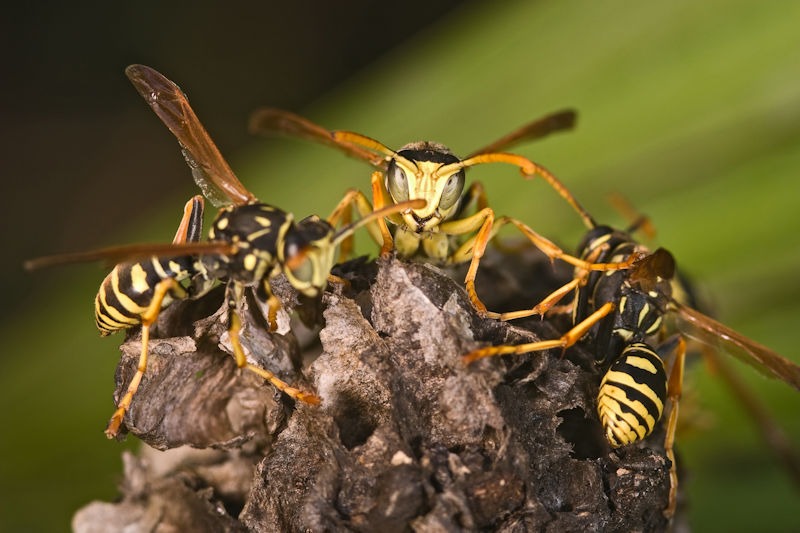Yellow jackets are a common and aggressive type of wasp that can cause significant issues for homeowners, especially during the warmer months. These pests are attracted to yards that provide them with food, water, and shelter. By understanding and addressing the conditions that attract yellow jackets, homeowners in Southern Maryland and Northern Virginia can significantly reduce the presence of these pests. This essay will explore various strategies for managing moisture, cleaning up the yard, maintaining outdoor structures, using deterrents, and creating a hostile environment for yellow jackets.
Managing Moisture and Water Sources
One of the primary factors that attract yellow jackets to a yard is the presence of moisture and water. Yellow jackets need water to survive, and standing water provides an ideal habitat for them. Homeowners should focus on eliminating standing water and improving drainage to make their yards less appealing to yellow jackets.
Tips for Reducing Standing Water:
- Inspect and Repair Gutters: Ensure that gutters are clean and free of debris to prevent water from pooling.
- Proper Drainage Systems: Install and maintain proper drainage systems to direct water away from your yard.
- Water Management: Avoid overwatering plants and lawns, and ensure that sprinklers are properly adjusted.
- Fill in Low Spots: Level out low spots in your yard where water can accumulate.
Regular Yard Clean-Up
Keeping your yard clean and free of organic debris is essential for reducing yellow jacket populations. Fallen leaves, yard waste, and other organic materials provide food and nesting sites for yellow jackets.
Best Practices for Yard Clean-Up:
- Regular Raking: Rake and dispose of fallen leaves and other organic debris regularly.
- Proper Composting: If you compost, ensure that the compost pile is well-managed and located away from your home.
- Waste Disposal: Dispose of yard waste promptly and avoid leaving piles of debris in the yard.
Maintaining Outdoor Structures
Yellow jackets often nest in sheds, garages, and other outdoor structures. Keeping these structures well-maintained and free of gaps is crucial for preventing yellow jacket infestations.
Maintenance Tips:
- Regular Inspections: Inspect sheds, garages, and other structures regularly for gaps, cracks, and other potential entry points.
- Sealing Gaps: Seal any gaps or cracks with caulk or other appropriate materials.
- Repairing Damage: Repair any structural damage promptly to prevent yellow jackets from finding shelter.
Using Yellow Jacket Deterrents
There are several natural and chemical deterrents that can help keep yellow jackets away from your yard. It’s important to use these products safely and effectively to avoid harming other beneficial insects and the environment.
Types of Deterrents:
- Natural Deterrents: Essential oils such as peppermint, eucalyptus, and lemongrass can be used to deter yellow jackets.
- Chemical Deterrents: Commercially available yellow jacket repellents can be used according to the manufacturer’s instructions.
- Traps: Yellow jacket traps can be used to reduce the population. Place traps away from areas where people gather to avoid attracting yellow jackets to those areas.
Creating a Hostile Environment for Yellow Jackets
Making your yard less appealing to yellow jackets involves a combination of strategies that disrupt their habitat and make it difficult for them to thrive.
Techniques:
- Sound Deterrents: Use ultrasonic devices that emit sounds unpleasant to yellow jackets.
- Light Deterrents: Yellow jackets are attracted to light, so using yellow or sodium vapor light bulbs can reduce their attraction to your yard.
- Plant Selection: Planting certain types of plants that are known to repel yellow jackets, such as wormwood and spearmint, can help reduce their presence.
Conclusion
By implementing these strategies, homeowners in Southern Maryland and Northern Virginia can significantly reduce the conducive conditions that attract yellow jackets to their yards. Regular yard maintenance, proper water management, maintaining outdoor structures, using deterrents, and creating a hostile environment for yellow jackets are all effective methods for keeping these pests at bay. Taking proactive steps not only helps in managing yellow jackets but also contributes to a safer and more enjoyable outdoor space.
References
– [Yellow Jackets and Other Stinging Insects](https://extension.umd.edu/resource/yellow-jackets-and-other-stinging-insects)
– [Managing Yellow Jackets and Paper Wasps](https://www2.ipm.ucanr.edu/agriculture/urban-pest-management/)
– [How to Control Yellow Jackets in Your Yard](https://www.gardeningknowhow.com/plant-problems/pests/insects/how-to-control-yellow-jackets.htm)
– [Integrated Pest Management for Yellow Jackets](https://ipm.ucanr.edu/PMG/PESTNOTES/pn7450.html)
FAQs
Q: What attracts yellow jackets to my yard?
A: Yellow jackets are attracted to food sources, water, and suitable nesting sites. Standing water, organic debris, and unmaintained outdoor structures can attract them.
Q: How can I safely remove yellow jacket nests?
A: It’s recommended to hire a professional pest control service to remove yellow jacket nests, especially if the nests are large or located in difficult-to-reach areas.
Q: Are there any natural ways to repel yellow jackets?
A: Yes, essential oils such as peppermint, eucalyptus, and lemongrass can be used as natural repellents. Planting certain plants like wormwood and spearmint can also help.
Q: How often should I inspect my yard for yellow jackets?
A: Regular inspections, especially during the warmer months, can help you detect and address yellow jacket activity early.
Q: What should I do if I get stung by a yellow jacket?
A: Clean the sting area with soap and water, apply ice to reduce swelling, and take an antihistamine to relieve itching. Seek medical attention if you experience severe reactions.
NEED HELP?
If you live in Southern Maryland, or Northern Virginia
FIND YOUR SOLUTION HERE
People, Pet & Pollinator Safe! Pest control for people who care.
